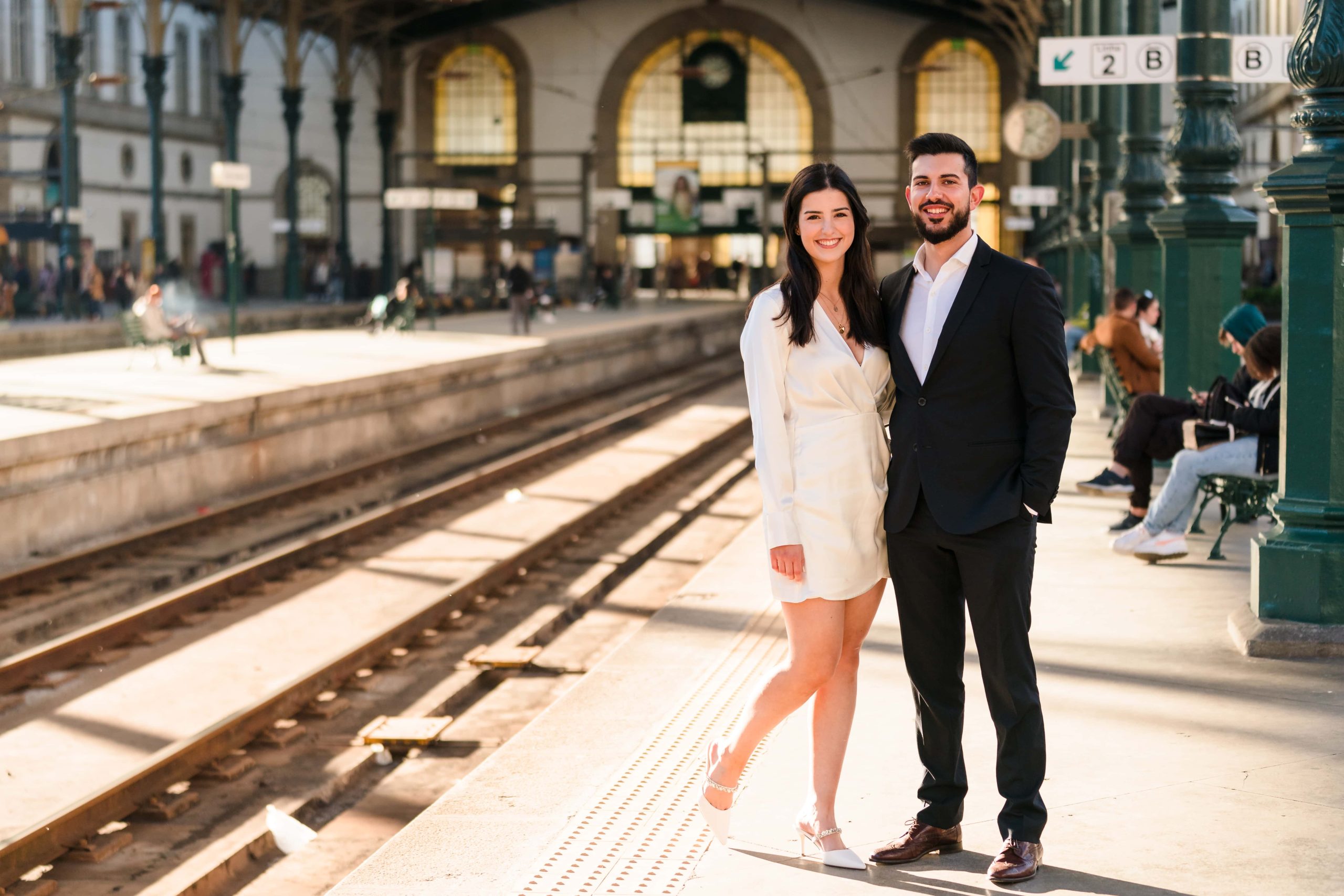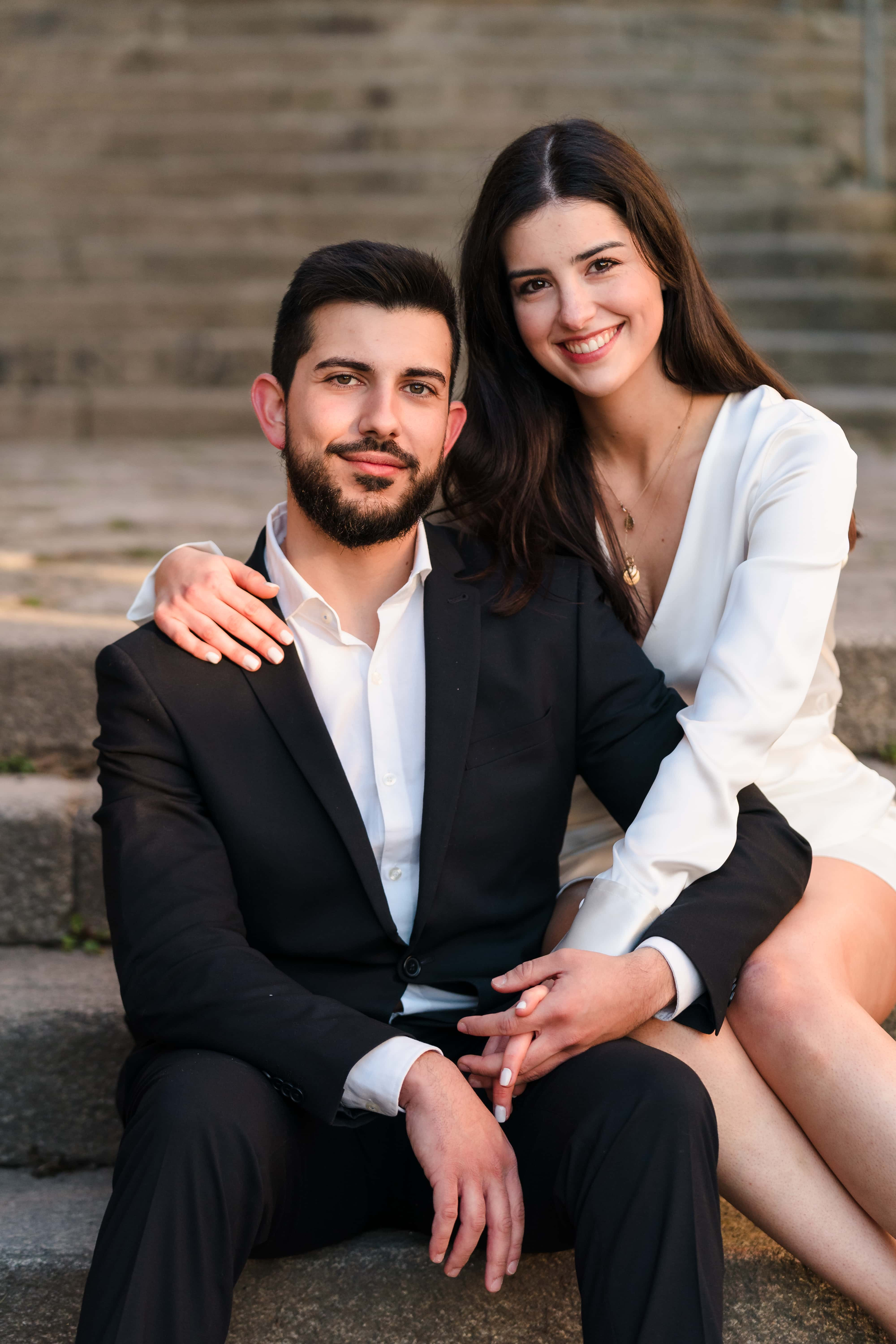Closet Guide – What to wear for your engagement shoot

We have specific recommendations depending on the venue you choose. However, we want you to wear clothes that show off your personality. It’s all about style and planning. The more time you invest in selecting a closet for your photo shoot, the happier you’ll be with the results. Leaving the details to the last minute creates stress and takes the fun out of the day. Don’t hesitate to ask us about color and accessory options. Clothing As a general rule, we suggest wearing solid colors, as stripes and patterns draw attention away from faces. It is also recommended that you avoid wearing turtlenecks and loose-fitting clothes, as these often make the neck appear non-existent and the body appear wider than it is. Also avoid wearing shorts as they tend to make the legs look shorter than they are. Colors Solid monochromatic colors are easier to coordinate, but primary or complementary colors also look good and stand out in the photo. Darker colors will make you look thinner, while lighter colors will make you look bigger. Wearing dark pants or jeans with dark shoes adds texture and makes the portrait more visually appealing. When choosing color schemes, consider not only what looks best on you, but also imagine what colors would look best in a frame decorating your home. Accessories Avoid wearing hats, hair ornaments or other items that don’t distract from the main purpose, which is the person Footwear To make the photos as appealing as possible, we suggest avoiding running shoes, white socks and heavy footwear. If you want more casual photos, wearing boots or sandals can work well.
Make-up – How to do your make-up for the engagement session photos

Looking good on camera doesn’t require a make-up artist, but professional make-up tips do help. Even if you prefer a natural look, the camera tends to exaggerate and create artificial flaws. These make-up tips help to enhance your appearance even more rather than detract from it in front of the camera. Make-up tips for the camera include a range of corrective and dramatic effects, as well as enhancing a person’s natural appearance. The key is to consider that images are two-dimensional, so shadows and highlighted areas may need to be highlighted, not highlighted or even simulated, for the best overall effect. Before applying make-up, start with smooth, toned and moisturized skin. If necessary, do a facial or exfoliating treatment. This minimizes uneven or artificial makeup application and promotes a healthy, glowing appearance. Minimize shadows: as photos are two-dimensional, the camera ages the subject by enhancing dark, fine lines and wrinkles. To compensate, gently apply a lighter shade of concealer to the darker areas: around the eyes and expression lines. Then, using an upward motion, apply a light layer of foundation make-up over the face, including the lips. Blend the make-up around the edges. Except for concealer work, use foundation makeup colors that match your natural skin color. Bronzer or Blush: Various make-up effects can be achieved with blush. Bronzer powder is widely successful and produces a natural or slightly sculpted appearance, depending on its application. To apply powder blush: remove excess from the brush and gently apply to the cheekbones and above the outer corners of the eyes up to the temples. For a guide to applying make-up, make a big peace sign with your hand. Rotate it 90 degrees towards your nose. With your palms out, place the tip of the “V” on your hairline and line it up with the corner of your eye and your bottom finger resting on your cheekbone. Concentrate the color on or one finger below this area on the cheek and on or above this area around the eyes. Apply a second thin layer to the checks and blend lightly at the edges as necessary. **Additional makeup tip: Bronzer makeup can also be applied to the sides of the nose to minimize the width. And, a darker shade of blush applied under the cheekbones produces more definition. Eyes and Lines: Unless you like the look or have the eyes for it, avoid very large lines, this makes the eyes look smaller and deeper. Try a smoky colored eyeliner pencil and blend a little if necessary. With liquid eyeliner, one option is to dot the eyeliner close to the base of the lashes, rather than creating a solid line. For a different look, limit the application of liquid eyeliner to the upper lid and/or the outer corners of the eyes. Smoky eyeshadow applied above the eyelids and blended into the outer corners of the eyes also creates a desirable effect; a highlighted brow area enhances this effect. **Additional make-up tip: to soften lines, lightly dust the eyelid and forehead area once or twice with a powdered make-up brush dipped in light pink blush. Lips: Most lips benefit from definition, even when lipstick is not usually used. For a natural but polished look, try a shade or two darker than your lip color, apply lip pencil, smudge your lips a little and use a little gloss or lipstick. **Additional make-up tip: apply a lighter lip color or gloss only to the center of the lips to enhance the appearance of a pout. Powder: When you don’t want your skin to shine – Apply a light layer of translucent powder over your face to avoid shine and set your makeup. Concentrate on the T-zone as necessary and apply sparingly to outlined or dry areas. Eyebrows: Before applying make-up, make sure your eyebrows are the right shape, as they affect facial expression. As a guide, line a pencil vertically along the edge of the nostril and inner corner of the eye. Do the same for the outer corner of the eye. This is a good start and finish for the eyebrow. If the eyebrow arch needs help, align the pencil with the edge of the nostril and the outer edge of the iris to determine the highest point of the arch. Brush the eyebrows outside these areas and use an eyebrow pencil for even more definition. Red eyes: to brighten the whites of the eyes and minimize redness, outline the inner lower eyelid with a light blue eye pencil.
